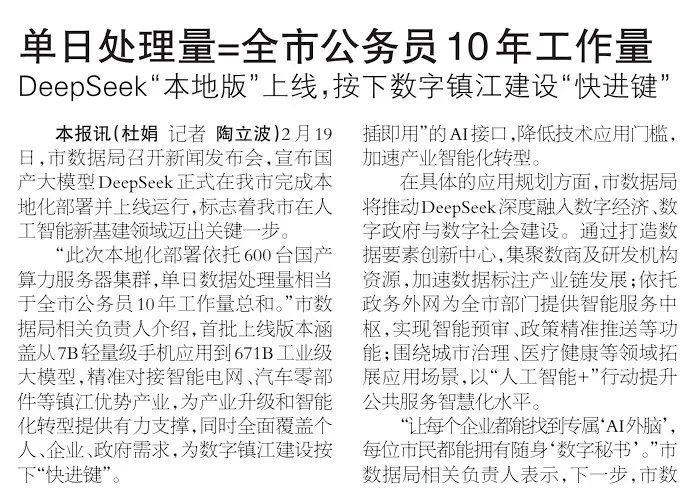Article source: AI Pioneer Officer
 Image source: Generated by AI
Image source: Generated by AI
Recently, the Zhenjiang City Data Bureau held a press conference. The relevant person in charge of the Municipal Data Bureau said that after the localized deployment of DeepSeek,”the data processing capacity in a single day is equivalent to the total workload of civil servants in the city for 10 years.”

Although the description was not rigorous enough, the information quickly went out of circles and attracted attention to the topic of “AI government affairs”.
“AI civil servants” are taking up their posts across the country.
Just a few days before the Zhenjiang press conference,Futian District of Shenzhen launched AI employees based on DeepSeek development, and the first batch of 70 employees took up their posts.
According to reports, these AI employees are distributed in 35 government units in the district, covering 240 government work scenarios such as document processing, people’s livelihood services, emergency management, and investment promotion.
In terms of office efficiency, the personalized customization generation time has been reduced from 5 days to minutes, the official document format correction accuracy rate exceeds 95%, the review time is shortened by 90%, and the error rate is within 5%.
Gao Zeng, member of the Party Leadership Group and Deputy Director of the Government Service and Data Management Bureau of Futian District, Shenzhen, said that AI digital employees are civil servant assistants and cannot make decisions alone. They are “not AI civil servants.”
In conjunction with this, Futian District has also launched the “Government Assisted Intelligent Robot Management Measures”, which defines the institutional boundaries for the role of AI in the government field, namely three principles:
The first is the ethical framework. AI is defined as an “auxiliary role”. Each digital intelligence employee needs to be equipped with a human guardian, and the responsibilities are clear;
The second is the safety threshold, and the manual intervention mechanism is retained at key decision-making nodes;
The third is scenario restrictions, clearly delineating the application areas of AI to avoid disputes caused by technology crossing boundaries.
In addition to Futian District, Shenzhen’s Bao ‘an District has also connected the DeepSeek+ Tencent Mixed Model to the government system to use AI to improve administrative efficiency.
The big background is Shenzhen’s unprecedented emphasis on AI.
On February 13, Shenzhen launched city-wide AI operation training; on February 16, based on the government cloud environment, it officially provided DeepSeek model application services to various districts and departments.
In terms of the concept of AI models, Hangzhou has been trending every day recently. Shenzhen seems to be setting a benchmark in AI application scenarios?
In addition to Shenzhen,”AI + Civil Servant” has been implemented in government systems in many places.
For example, Guangzhou launched DeepSeek-R1 and V3671B models, which are applied to government affairs such as the people’s livelihood policy interpretation system and 12345 hotline work order allocation.
For example, Chongqing’s Dadukou District launched the “Digital Intelligence Grid Worker” system to achieve rapid responses to common questions by collecting public inquiries.
In addition, there are Ganzhou in Jiangxi, Wuxi in Jiangsu, Urumqi in Xinjiang, Linyi in Shandong, Hohhot in Inner Mongolia, etc.
AI’s entry into the field of government affairs is not the first in my country.
For example, Singapore has launched a special “Pair” system to help civil servants improve work efficiency, which has been widely praised.
The United States and the United Kingdom have also applied AI technology to the field of public services, playing a significant role in predicting crime trends, optimizing traffic flow, and identifying fraud.
As Gao Zeng, member of the Party Leadership Group and Deputy Director of the Government Service and Data Management Bureau of Shenzhen’s Futian District, said, in the short term,”AI civil servants” will only be assistants and cannot completely replace manual labor.
But in the long run, a new AI-driven government system will be the general trend.
This is first related to the particularity of government services. Government services are highly standardized, standardized, and process-oriented, and these are precisely the tasks that AI is best at handling.
Compared with “people”, they have advantages in efficiency and error rate.
Taking the “Zhejiang Office” APP in Zhejiang Province as an example, its “Smart Second-Office” service uses AI to automatically verify materials, reducing the processing time for corporate cancellations, social security transfers and other matters from an average of 3 working days to 10 minutes, with an accuracy rate of 98.3%.
The annual report of the Beijing City Government Service Bureau shows that the “smart customer service” system launched by the bureau will handle a total of 120 million consultations in 2023, and 85% of common questions will be answered in seconds.
Different from general perception,”AI civil servants” are not without warmth and emotional perception.
A report from the Data Resources Administration Bureau of Hangzhou City shows that its “Qinqing Online” platform uses AI emotion recognition technology to sense anxiety during public consultation in real time, and automatically transfers manual agents, reducing the complaint rate by 45%.
At the same time, with the wider application of “AI civil servants”, it is also expected to accelerate the exchange of government information and further promote the level of government and social services.
In addition, some optimizations that the government service concept and system may bring about are also worth looking forward to.



